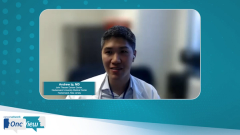
L-MIND Trial: Tafasitamab plus Lenalidomide in Relapsed/Refractory DLBCL
An overview of the L-MIND trial of tafasitamab plus lenalidomide in patients with relapsed/refractory disease.
Episodes in this series

Transcript:
Andre H. Goy, MD: Let’s move back into the relapsed/refractory setting, where there has been a plethora of novel agents approved. And we’ll talk more about CAR [chimeric antigen receptor] T-cell therapy in a second, but it was the L-MIND study [NCT02399085]. [Talk about] the L-MIND study. There was a long-term follow-up that showed durable responses. What do you think of these data?
Andrew Ip, MD: The L-MIND study is using a CD19 antibody called tafasitamab that’s given IV [intravenously], and it’s also in combination with lenalidomide. We know lenalidomide has good activity for large B-cell lymphoma, and it seems to synergistically work with tafasitamab. That’s what’s led to its approval for relapsed/refractory DLBCL [diffuse large B-cell lymphoma]. The L-MIND, at least the abstract that was presented at ASH [American Society of Hematology Annual Meeting], was an update on patients who received the drug for over 2 years. Typically, the lenalidomide is stopped maybe after 12 cycles, 12 months, but the tafasitamab could continue every 2 weeks until progression or intolerability.
And I’ll be honest, when I saw the data presented, it wasn’t that impressive to me because they’re cherry-picking the patients who are able to be on treatment for over 2 years. So of course, if they’re on treatment for over 2 years, they’re already responding, clearly, and they’re on the drug for a reason. So there are many more overall response rates in this population—they quoted over 90%—and their overall survival rate was very high, over 90% at 4 years. And that again reflects that these patients are able to tolerate treatment and are also already responding. At least from these updates on patients on long-term tafasitamab, it didn’t really move the needle per se, to say tafasitamab and lenalidomide need to be given as a more preferred relapsed DLBCL treatment.
Andre H. Goy, MD: I agree. Some patients had a durable response, and it’s an immunotherapy basically.
Andrew Ip, MD: Every 2 weeks, it’s IV. It’s not easy.
Andre H. Goy, MD: Yes, it’s not easy, but there was no patient that was primary refractory. And we know that the real challenge in large cell lymphoma is that 80% of the failures occur early and this is the difficult population. And later relapse can do well with a lot of different things. This is an interesting approach because it’s feasible in other patients and all of this, but I agree with you that this is a specific population.
Andrew Ip, MD: For the audience to know, they had 81 patients in their initial phase 2 study, and then they’re reporting on about 27 patients who got over 2 years of tafasitamab, of which only 3 or 4 were refractory. So a very small percentage of what we actually probably see, which is more like maybe 20% of patients will relapse and be considered refractory in the first 12 months post-R-CHOP [rituximab plus cyclophosphamide, doxorubicin hydrochloride, vincristine sulfate, and prednisone] or post-first-line.
Transcript edited for clarity.
Newsletter
Stay up to date on recent advances in the multidisciplinary approach to cancer.





















































































